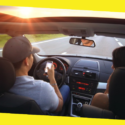How Has Driver Assistance Technology Advanced?
This post was last updated on November 23rd, 2024

When we look at buying a new car, the technology on offer can often sway our decision. Whether it’s a built-in sat-nav to help you get from A to B, or alarms to prevent you from crashing when parking, driver-assistance technology is now a main selling point. In years gone by, it was power steering and electric steering. As technology advances though, so too does our range of driver-assistance tools.
As we get closer to the prospect of 10 million self-driving cars being on the road that was claimed in 2016, here, with Lookers, who provide a variety of vehicles such as the Ford Kuga Titanium, we look at driver assistance technologies which are now becoming standard in the UK.
Driver drowsiness detection
Driving while you’re tired kills. While there has previously been campaigns to target driver fatigue, which introduced signs on motorways telling drivers not to drive tired, some cars nowadays come with driver drowsiness detection. It’s thought that falling asleep behind the wheel may be a factor in 10% of all road accidents and car companies have introduced the technology to try to eliminate this risk. The system works by recognising tell-tale signs, such as a driver’s head nodding that indicates sleepiness.
Parking sensors
Parking sensors are a great way to make sure you avoid any unnecessary bumps. It’s common knowledge that car parks are breeding grounds for accidents. Stats found that Britain is a nation of terrible parkers, with two-thirds of drivers admitting that their vehicles have been damaged in a car park. Parking sensors can help avoid these unwanted prangs – from your end at least. With a series of beeps alerting you as you get closer to any close objects – or sometimes an illustration on a parking camera – parking sensors can make sure you avoid scrapes. This not only saves your car from depreciating rapidly in value, but also saves any unwanted insurance claims going against you.
Adaptive light control
For some, driving in the dark is a nervous occasion. While your lights can beam into the distance, sometimes this isn’t enough. That’s where adaptive light control has been brought in to be of assistance. Designed to help drivers see better in the dark and see further, this assistance enables your headlights to swivel and rotate so that the road in front of you is more illuminated, especially round corners.
Tyre pressure monitoring
Not only does this help with your driving capabilities, it can also save you money as poor tyre pressure can waste fuel consumption. The tyre pressure monitoring systems will allow you to know when to pump your tyres up without needing to get out of your car and physically check. However, it’s important to always carry a car tyre pump in your boot to be on the safe side.
Lane departure warnings
On a busy motorway, you often see cars swaying slightly and threatening to cut into your lane. However, with lane departure warning systems, you can ensure your own vehicle doesn’t drift out of your allotted lane as an alarm will sound to make sure you take corrective action and stay safely within the lines. Some lane-keeping assistance systems are also available, and these go a step further by making automatic small corrective actions without any driver input.
Semi-autonomous driving
Cruise control has long been an option, while driverless cars are drifting closer to becoming a reality. However, for now, semi-autonomous driving is a feature that is available in luxury models. For those of us who find ourselves regularly travelling, this gadget allows us to relax on the road as it helps the car maintain a constant speed while staying in lane and watching out for potential collisions. Although it shouldn’t be seen as a tool to replace driving, it’s said to reduce fatigue on those long and tedious drives.
Built-in sat nav
The days of pulling over and reading the map to find your destination certainly appear to be a thing of the past. While you can still buy satellite navigation systems, and devices such as mobile phones have the automatically installed, your car can now include a built-in sat nav. Simply type in your destination and away you go – no questions asked.
Blind spot detection
Unfortunately for some of the sleeker car designs on the market, this comes with a drawback — a larger blind spot. That’s where the blind spot detection feature is proving useful. It works by alerting you when another vehicle that is outside of your direct field of vision is approaching. It can do so in several ways, including a warning sound, a light on your side mirror, or a vibration of the steering wheel.
It’s clear that technological advances are improving our driving experience and car dealers are acknowledging this. Next time you’re in the market for a new car, see what is available to assist you on your journey. Besides automated driving, what will be next?
Sources
- https://www.telegraph.co.uk/motoring/columnists/James-Foxall/10260587/Why-car-add-ons-dont-add-up.html
- https://moneyinc.com/top-five-luxury-add-ons-car/
- https://www.express.co.uk/life-style/cars/727980/Two-thirds-drivers-say-vehicles-damaged-car-parks
- https://www.autotrader.co.uk/content/advice/what-is-bluetooth-in-a-car
- https://www.raccars.co.uk/news/heated-car-seats-or-no-heated-seats
- https://www.torquecars.com/tuning/alloy-wheels.php
- http://www.autoexpress.co.uk/car-news/consumer-news/97348/uks-favourite-car-colours-20-of-all-cars-sold-in-2017-were-black
- https://www.lifewire.com/advanced-driver-assistance-systems-534859
You may like this
Recommended For You
Different Types of Racing Car Safety Equipment
Most Inside
Most Inside offers high-quality recommendations and valuable updates to enhance all aspects of your life, providing premium guidance and enriching experiences.




